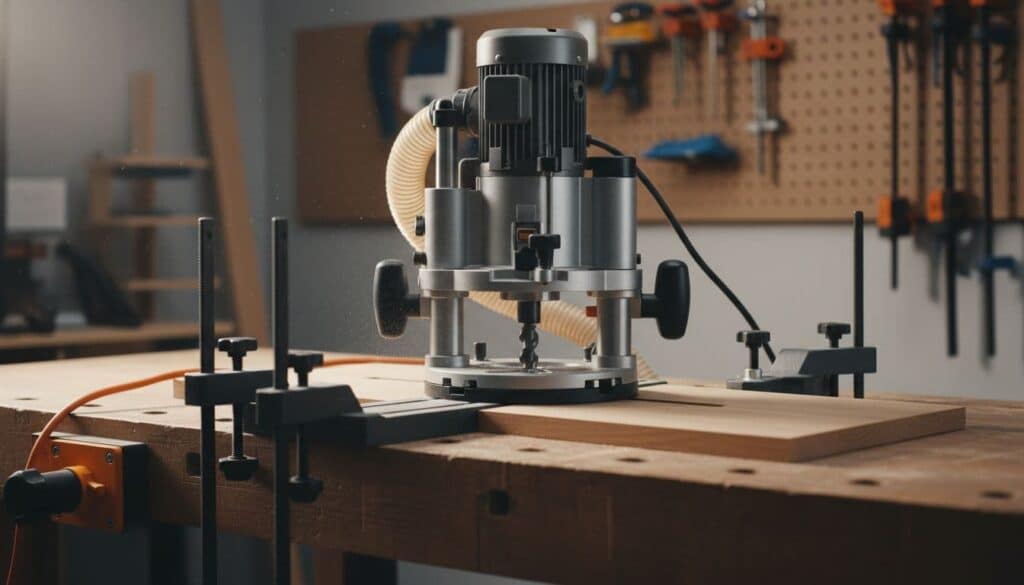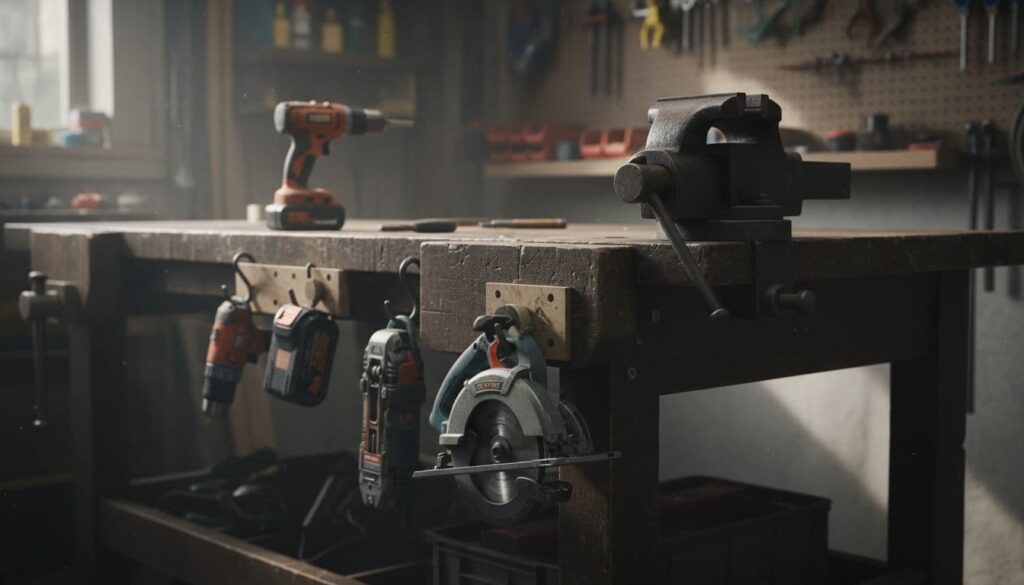Woodworking Niche Case Study: An Evergreen Affiliate Playbook
When I started mapping out this Woodworking Niche Case Study, I treated it like I was building a workbench from scratch. The goal was not theory, but a real roadmap that a newer affiliate, who already likes sawdust and tools, can follow in 2025 without guessing at every step. The woodworking market keeps growing, and buyers are hungry for honest gear advice, clear project ideas, and simple “buy this, skip that” guidance.
In this post, I am going to take you through the same process I use for my own sites. We will look at the top markets inside woodworking, then break them into 24 practical sub-niches that you can actually build content around. You will see a detailed customer avatar, so you know exactly who you are writing for, what they search for, and what they are ready to buy.
I will also share realistic earning ranges, not fantasy screenshots. You will see what is possible for a small starter site, what a focused part-time project can reach, and what a serious content hub might earn if you stick with it. Along the way, I will point to real product types and offers, like the top affiliate products for DIY woodworking, that can plug straight into your plan.
To make this easy to act on, you will get a concrete list of 30 product review ideas you can publish early, even if your site is brand new. By the time you finish this case study, you will have a clear niche angle, a content path, and a simple way to turn your love of woodworking into steady affiliate income. Grab a coffee, picture your ideal reader at their workbench, and let us build out your 2025-2026 affiliate playbook step by step.
Why the Woodworking Niche Is So Strong for Affiliate Marketers in 2025
When I first looked at the numbers for this Woodworking Niche Case Study, it confirmed what my gut already told me. Woodworking is not just a hobby anymore; it sits at the crossroads of DIY, home improvement, side hustles, and sustainable living. That mix is exactly what you want as an affiliate in 2025.
More people work from home, spend more time fixing up their space, and want a “hands-on” hobby that pulls them away from a screen. At the same time, the search demand for tools, project ideas, and plans keeps climbing, and there are strong offers across all price ranges. From simple beginner kits to high-ticket tools and recurring plan memberships, this niche gives you many ways to earn from one audience.
Let us break down why the momentum is so strong right now.
Key 2025-2026 woodworking trends that drive affiliate sales
Here are the big trends that matter for you as an affiliate, not just as a fan of woodworking.
1. DIY and hobby growth
More people want projects they can do at home on nights and weekends. They search for:
- “Beginner woodworking projects”
- “How to start woodworking at home”
- “Best tools for a small woodworking shop”
Every one of those searches can lead to guides, tutorials, and tool reviews with affiliate links. When someone is just starting out, they need everything, which means more clicks and larger carts.
2. Eco-friendly wood products
Sustainability is not a buzzword here; it shows up in how people buy. They want:
- Reclaimed wood
- FSC-certified lumber
- Low-VOC finishes and natural oils
This opens the door to content around eco-safe finishes, responsible lumber sources, and “green” shop setups. Those guides can link to higher margin specialty finishes and premium wood suppliers. Lists like the best woodworking affiliate programs for green and hobby audiences show how many brands now push eco and quality in their marketing.
3. Small home workshops and side hustles
The garage, spare room, or even a balcony becomes a money-making mini shop. People search for:
- “Small workshop layout”
- “Wood projects that sell”
- “Woodworking side hustle ideas”
Content that helps them turn space into income is perfect for high-ticket items like table saws, dust collection, and storage systems. Guides that connect layout plans with tool recommendations can stack several affiliate products into one helpful post. If you combine that with ideas from lists of wood projects that sell well in 2025, you can create “from tool to profit” content that converts very well.
4. Social media and video content for woodworking
Short videos and step-by-step builds drive a ton of traffic. A quick reel or YouTube Short that shows a project from start to finish can push viewers to a full blog tutorial. On that page, you list every tool, plan, and material with affiliate links. Even a small channel can send steady buyers to detailed posts, especially when you focus on clear, “do this next” calls to action.
5. Seasonal wood projects for holidays
Holiday decor, gifts, and seasonal home upgrades often spark increased interest. Think:
- Christmas ornaments and trees
- Halloween decor
- Mother’s Day and Father’s Day gifts
- Wedding and baby shower signs
Seasonal project guides are perfect for fast-selling, low-ticket items like finishes, bits, blades, and clamps. They also bring in new visitors who might later move into bigger projects and tools.
Top woodworking markets: tools, plans, and profitable projects
When I mapped out this Woodworking Niche Case Study, I cut the niche into simple markets that match how people actually shop. Each of these can be a “lane” for your site or channel.
1. Tools and machinery
This is where many affiliates see their largest single commissions.
- Table saws, miter saws, and planers
- Dust collection, compressors, and shop vacs
- Cordless tool systems and combo kits
These are classic high-ticket items, and many brands appear in lists of strong woodworking affiliate programs and networks. A single sale can beat ten or twenty sales of small consumables.
2. Woodworking plans and blueprints
Plans are perfect for recurring or stacked sales.
- Plan subscriptions and membership sites
- One-off project packs (furniture sets, outdoor builds)
- Printable PDFs and CAD files
Many plan sites run recurring commissions, so you earn as long as the member stays active. They also fit naturally inside tutorials and “tools you need for this build” posts.
3. DIY kits and beginner sets
Beginners like kits because they reduce decision stress.
- Complete project kits (birdhouses, shelves, small tables)
- Starter tool bundles
- Pre-cut lumber packs
These convert well from “start woodworking” and “easy weekend project” content. Kits are also friendly for readers who feel lost when they see long tool lists.
4. Accessories and consumables
Consumables are less sexy, but they move constantly.
- Sandpaper, glue, screws, and hardware
- Finishes, oils, and stains
- Safety gear and masks
These give you repeat sales over time, especially if your readers use your gear lists every time they start a build.
5. Education (books, courses, and memberships)
Some readers would rather follow a full path than bounce between random videos.
- Beginner woodworking courses
- Skill-focused classes (joinery, cabinet making)
- Books and premium communities
Education offers can live in learning paths, such as “From your first cut to your first paid project”. They are also easy to connect with broader DIY home improvement affiliate programs when your content overlaps with home projects.
How this Woodworking Niche Case Study helps you pick a winning angle
When I started planning this Woodworking Niche Case Study, I knew the biggest risk for new affiliates was going too broad. “Woodworking” as a topic is huge. If you try to cover everything, you end up with thin content, weak rankings, and confused readers.
The goal of this case study is to help you pick a clear angle.
You might decide to focus on:
- Beginner tools and starter setups
- Small shop layouts for garages and spare rooms
- Eco-friendly projects with reclaimed wood and safe finishes
- Profitable projects that sell at local markets and online
Later in the post, you will see a list of 24 sub-niches and 30 specific post ideas. Those lists are there so you can move from planning to action and publish your first batch of content without staring at a blank page.
My suggestion is simple: pick one or two markets to start. Maybe you mix “small home workshops” with “beginner tools”, or “eco-friendly projects” with “plans and kits”. By narrowing like this, you make it easier to rank, easier to write great content, and easier for readers to see what your site is about.
As you grow, you can add more markets, but the first step is a clean angle that lines up with your own interests and what your future readers are already trying to build.
Customer Avatar: Who Actually Buys From Woodworking Affiliate Sites
When I mapped out this Woodworking Niche Case Study, I kept coming back to one simple idea. If you know exactly who is behind the screen, you can write content that feels like a helpful buddy in the shop, not a sales page. Let us start with the main person who lands on your site, then we will zoom out to the other buyers your content can quietly serve.

Primary woodworking customer avatar for affiliates
In my head, the primary avatar looks like this.
He is 38 to 52 years old, lives in the US, Canada, the UK, or Australia, and works a regular job in tech, trades, teaching, or management. His income is solid middle to upper-middle class, so he can afford decent tools, but he hates wasting money.
Most stats still show woodworking as male-heavy, with a clear gap between men and women in the trade and hobby side, like the gender mix you see in woodworker demographics in the United States. On the hobby side, more women join every year, often starting with smaller projects, decor, or kids’ builds. So I picture a growing female group in that same 30 to 55 age range, often very detail-focused and safety aware.
This person likes:
- DIY and home improvement, especially fixing or upgrading their own space
- Hands-on hobbies that calm them down after a day on a computer
- Quality and safety, even if it costs a bit more
Their goals usually fall into a few simple buckets:
- A relaxing hobby that feels productive, not passive
- Building real furniture for their home, not just buying flat-pack
- Saving money by learning skills instead of hiring everything out
- Testing the waters for a small side hustle, like selling boards or decor
Along with the goals come some strong fears:
- Wasting money on tools that will sit in a corner
- Buying the wrong model and regretting it every time they use it
- Safety issues, especially with table saws, finishes, and dust
- Feeling overwhelmed and quitting because there are too many choices
When this avatar lands on your post, they want you to act like the steady friend who has already made the mistakes. That is why content that mixes clear how-to steps, honest pros and cons, and straight product picks works so well. Your job is to cut through noise and give them a clear path, one project or one purchase at a time.
Search intent and content needs of woodworking visitors
To line up your content with this avatar, pay attention to what they type into Google and YouTube when they sit down after work. It usually starts with basic, safety-focused, or money-focused questions.
Common informational searches:
- “How to start woodworking at home”
- “beginner woodworking projects that don’t need many tools”
- “How to use a circular saw safely”
These call for tutorials and step-by-step guides. Simple posts with photos or videos, a short tools list, and clear instructions are perfect here. You can weave in affiliate links inside “what you need for this project” sections without breaking the flow.
Next, they move into comparison intent:
- “best beginner woodworking tools”
- “corded vs cordless circular saw”
- “benchtop planer vs thickness planer”
This is where comparison posts and “X vs Y” articles shine. Break down features, real use cases, and who each tool is for. Short tables with specs and simple verdicts help readers choose without feeling buried in numbers.
When they are close to buying, the searches shift to buying intent:
- “Which miter saw to buy for a small shop?”
- “best budget table saw under 500”
- “safe wood finish for kids’ toys”
Here, deeper product reviews and buyer guides win. These readers want:
- A short answer at the top, like “this is the best pick if…”
- A few strong alternatives by budget or skill level
- Extra confidence around safety, warranty, and long-term value
You can support this with links to trusted data on hobby and craft spending, like recent handmade and craft industry statistics for 2025, to show that people really are investing in their hobbies.
The key is to write in plain language. Explain why a feature matters, not just what it is. If you match each post to a real search phrase that your avatar might type, your whole Woodworking Niche Case Study becomes a practical roadmap instead of a random pile of content.
Secondary avatars: parents, gift buyers, and small shop owners
Alongside that main hobbyist, there are a few secondary avatars that can quietly boost your earnings if you plan for them.
Parents and grandparents buying for kids
These buyers search for things like “woodworking kits for kids,” “safe tools for teens,” or “STEM woodworking projects.” They care about:
- Safety and non-toxic finishes
- Clear instructions and age ranges
- Educational value and screen-free time
This group is perfect for kids’ kit reviews, “best starter sets by age,” and project roundups that highlight family builds.
General gift buyers
These visitors show up before birthdays and holidays with searches like “woodworking gift ideas,” “tool set gift for dad,” or “woodworker gifts under 100.” They often know very little about tools. They just want a safe, thoughtful pick. This is your chance to write:
- Gift guides by budget
- Roundups of unique or custom tools
- Short blurbs that explain who will enjoy each item
Serious hobbyists and semi-pros
Finally, you have the upgrade crowd. They already own a basic saw and drill, and now they search for “upgrade from entry-level table saw,” or “best miter saw for furniture making.” They spend more, but they need trust before they pull the trigger.
They respond well to:
- High-ticket buyer guides with clear tiered picks
- “What I wish I upgraded sooner” style posts
- Deep dives into dust collection, shop layout, or accuracy upgrades
These secondary avatars open up angles like holiday gift guides, kids’ sections, and premium tool upgrade hubs. When you line them up behind your main avatar, you end up with a site that covers the full journey, from first kids’ kit to serious small shop.
24 Profitable Woodworking Sub-niches for Affiliate Marketers
When I broke this Woodworking Niche Case Study into a real 2025 content plan, I stopped thinking of “woodworking” as one big blob. Instead, I mapped 24 tight sub-niches that you can turn into pillars, supporting posts, and product clusters that feed each other with internal links and consistent buyer intent.
Most of these can cross-link inside one site. A table saw review points to dust collection, that post links to safety gear, which leads to project plans, and so on. That is where the real affiliate income starts to stack.
Core sub-niches: essential woodworking tools and machinery

These are the backbone of most woodworking affiliate sites and hold some of the best high-ticket options.
- Power tools
Circular saws, jigsaws, drills, routers, and combo kits. Great for “best starter tools” and “upgrade” guides with mid to high-ticket ranges. - Hand tools
Chisels, planes, hand saws, mallets, and marking knives. Lower ticket, but huge variety and strong “beginner hand tool kit” content. - Woodworking machinery
Table saws, band saws, planers, and jointers. Classic high-ticket products that work well in comparison reviews and “shop upgrade” posts. - Sanding machines and polishers
Random orbital sanders, belt sanders, polishers. Ideal for “best sander for furniture refinishing” style content where people are ready to buy. - Joinery tools and jigs
Pocket hole systems, dovetail jigs, doweling jigs, biscuit joiners. Perfect for tutorial-based posts that show how to build stronger joints. - Clamps and workholding
Bar clamps, parallel clamps, corner clamps, and bench dogs. Low to mid-ticket, but almost every build guide can feature them.
You can support these with “best of” lists, brand vs brand matchups, and price-tiered guides. Articles like broad affiliate marketing sub-niche lists for 2025 show how tool-heavy niches keep performing because people always upgrade.
Materials, finishes, and consumables sub-niches
This group rarely gives you huge single commissions, but the volume and repeat buying can be excellent. 7. Wood materials and eco lumber
Dimensional lumber, plywood, hardwood boards, reclaimed or FSC-certified wood. Great for “what wood to use for…” guides and eco-focused content. 8. Wood finishes, oils, and stains
Polyurethane, hardwax oils, shellac, and outdoor sealers. These are needed for almost every project and work well in before-and-after tutorials. 9. Wood glue and adhesives
PVA glue, epoxy, CA glue, and construction adhesives. Cheap, but used constantly, and easy to recommend in every project list. 10. Sanding supplies and abrasives
Sandpaper sheets, discs, sanding sponges. These are pure consumables that fit into step-by-step build posts.
You can pair these with project ideas that sell, especially if you study lists like 50 profitable woodworking projects that sell in 2025 and then reverse engineer the materials needed.
Plans, education, and software sub-niches
This cluster often pays higher margins and, in many cases, recurring commissions, which is perfect to balance out tool content. 11. Woodworking plans and plan memberships
One-off plans, multi-project bundles, and subscription libraries. Strong fits for “best plan subscription services” and project roundups. 12. Books and eBooks
Beginner guides, joinery books, furniture design titles. Easy to promote in “top woodworking books for beginners” or skill-path posts. 13. Online woodworking courses
Video-based classes and full learning paths. Often higher payout per sale and ideal for readers who want structure. 14. CAD and design software
SketchUp plugins, dedicated woodworking design tools, and cut list generators. Great for advanced readers who want precision and repeatable results.
These pairs naturally pair with tool posts and with broader content on top, crafting hobbies for affiliate success if you ever expand into related niches.
Safety, storage, and workshop setup sub-niches
This is where beginners live. They want a safe, tidy, and efficient space, even if it is a one-car garage. 15. Safety gear and PPE
Glasses, hearing protection, respirators, gloves, and aprons. Easy to slot into every tool or project post as a “non-negotiable” gear. 16. Measuring and layout tools
Tape measures, squares, marking gauges, and calipers. These are precision-focused items that convert well in “accuracy upgrade” content. 17. Workshop organization and storage
Tool walls, drawer systems, parts organizers. Ideal for “small workshop” and “garage setup” guides. 18. Workbenches and workstation systems
Fixed benches, folding benches, and mobile stands. Often mid to high-ticket and core to any first-shop build. 19. Dust collection and air filtration
Shop vacs, dust extractors, hose kits, air cleaners. High-impact, safety-focused gear that fits great in upgrade or health-focused posts.
Kids, hobby kits, and advanced tech sub-niches
This last cluster lets you mix low-ticket impulse buys with serious high-ticket tech gear. 20. Kids’ woodworking kits
Age-rated kits with pre-cut parts and simple tools. Great for parents and grandparents who want safe, educational gifts. 21. Small project and furniture kits
Birdhouses, shelves, small tables, and decor sets. Ideal for “weekend project” and “wood projects that sell” content, like the ideas in Shopify’s guide to woodworking projects that sell online. 22. CNC and laser machines
Desktop CNC routers and laser engravers. Big-ticket items that pair well with content about turning woodworking into a side business. 23. Wood carving and whittling supplies
Carving knives, gouges, rotary tools, and blanks. Great entry point for readers who feel nervous around large power tools. 24. Wood drying and treatment gear
Moisture meters, sealers, stabilizing resins. Niche but profitable for advanced users who sell furniture or high-end pieces.
Once you see these 24 sub-niches laid out, it becomes much easier to plan your own site. You can pick a “home base” cluster, then connect into two or three related clusters so your Woodworking Niche Case Study turns into a real, tightly linked affiliate ecosystem rather than a random pile of reviews.
Woodworking Affiliate Earnings: How Much Can You Realistically Make?
When I ran the numbers for this Woodworking Niche Case Study, I wanted something simple. No flashy screenshots, just what a focused affiliate can earn if they show up, publish, and keep improving. The truth is, income grows in stages. At the start, it feels slow, then a few pages rank, clicks turn into sales, and the graph begins to climb.
If you think of your site like a workshop, the early months are setup, not payday. The good news is that once the “shop” is built with solid content, it can run for years with steady updates.
Beginner earnings in the woodworking niche
For a new woodworking affiliate who posts regularly and does basic SEO, the first 6 to 18 months usually sit in the tens to low hundreds per month, then climb toward $300 to $500 per month once a few core posts rank.
Here is what that might look like:
- Months 1 to 6: $0 to $100 per month, mostly from early Amazon or tool sales.
- Months 6 to 12: $100 to $300 per month, as beginner tool guides and “best X for small shops” posts settle into page one or two.
- Months 12 to 18: $300 to $500 per month, if you have a small cluster of reviews and tutorials bringing in consistent clicks.
The biggest shortcut for beginners is not volume; it is focus. Three things help a lot:
- Long-tail keywords like “best miter saw for tiny garage shop” or “safe wood finish for kids’ toys”. These have less competition and clear buying intent.
- Topical authority in one sub-niche, for example, small shop setups or beginner hand tools. You become the “go-to” source in one corner of the market.
- Fair commission programs, such as brands listed in roundups of top woodworking affiliate programs, so each sale actually moves the needle.
At this stage, think in simple goals. Ten to twenty focused posts, updated and improved over time, can support that first $300 to $500 per month milestone.

Scaling to four or five figures per month with woodworking content
Once you know how to rank and convert visitors, the numbers shift. Experienced woodworking affiliates who publish strong content, build email lists, and promote higher-value tools can reach $5,000 to $10,000+ per month, but it usually comes after a few years of steady work.
Here is a simple math example:
- Average commission per tool sale: $20
- 300 sales per month across guides and reviews: 300 x $20 = $6,000
Or, if you mix in higher-priced tools and plans:
- 60 sales of $100 commission items, like better machines or premium plan bundles: 60 x $100 = $6,000
- 150 sales of $10 commission items, like bits, finishes, and small tools: 150 x $10 = $1,500
Total: $7,500 per month
This kind of income usually needs:
- 100+ quality posts that cover one or two tight topic clusters
- A list or simple funnel that brings readers back for new projects and tools
- Testing of calls to action, layouts, and offers so that more visitors click and buy
Good affiliate programs help a lot here. Some plan memberships and bundled offers, like those covered in woodworking affiliate program breakdowns for 2025, pay better than basic Amazon links.
The pattern stays the same. Traffic, conversion rate, and average commission decide your ceiling. Hype does not move any of those; consistent testing and better content do.

Ready to get STARTED?
Wealthy Affiliate has all the tools and training you will ever need to build your passion for woodworking into a hobby site or full-time business. Share your value and get a new lease on life. All for less, you think with a free starter membership that lets you try before you buy.
Join Wealthy Affiliate Free TodayHigh-ticket opportunities: CNC machines, machinery, and premium plans
The real income jumps in my own projects came when I stopped relying only on sandpaper, glue, and $8 commissions. Woodworking has powerful high-ticket angles, especially CNC machines, larger shop machinery, and premium plan memberships that can pay $100 to $300+ per sale or more.
For example:
- A mid-range CNC or serious table saw might pay $150 per sale.
- A premium annual plan membership could pay a $100 one-time commission or a recurring cut each year.
If just 20 people per month buy through your links:
- 10 high-ticket tools at $150 commission each = $1,500
- 10 premium memberships at $100 commission each = $1,000
That is $2,500 per month, before you even count smaller items.
To earn those clicks, you need deeper content than a quick “top 5” list. High-ticket buyers want:
- In-depth reviews that cover setup, real use, and who the machine is for
- Tutorials and build logs that show what they can actually make with the tool
- Comparison guides, for example, “CNC A vs CNC B for a one-car garage shop”
I like to mix high-ticket and low-ticket in the same posts. A CNC review can link to bits, clamps, software, and dust collection. That mix smooths out income, so you are not waiting for one big sale to save the month.
When you zoom out across this Woodworking Niche Case Study, the pattern is clear. Early on, a few hundred dollars per month is realistic if you publish and learn. As your traffic, trust, and offers grow, four and even five-figure months become a math problem, not a fantasy, as long as you keep feeding the “shop” with useful, honest content.
30 Product Review Post Ideas for a New Woodworking Affiliate Site
When I mapped out this Woodworking Niche Case Study, I treated the first 30 posts like a starter product catalog. The goal was simple: pick review and buyer guide topics that attract real buyers, not just casual browsers, and cluster them in a way that builds topical authority fast.
Think of these 30 posts as your first 3 to 6 months of content. Each one has a clear product focus, a search intent, and a buyer in mind.
Beginner tool kits and essential starter gear (posts 1–6)
Your very first batch should speak to the true beginner who has more questions than tools. These six posts can capture that early-stage visitor who is about to spend their first few hundred dollars.
- “Best Beginner Woodworking Tool Kits for 2025”
This is your big starting post. Compare complete starter kits by budget, brand, and what is actually useful. Pull ideas from guides like this woodworking starter kit breakdown, and add your own testing or opinions. Angle: “Avoid wasting money, buy one kit that covers 80% of what you need.” - “Top Cordless Drills for Beginner Woodworkers”
Focus on drills that handle wood screws, pocket holes, and light drilling. Sort picks by price and battery platform. Angle: “best cordless drills for small wood projects and future upgrades.” - “Best Starter Miter Saws for Small Shops and Garages”
Compare compact miter saws that fit on a small bench or stand. Highlight cut capacity, safety features, and dust ports. Angle: “best miter saws if you are working in half a garage.” - “Hand Saw Brand Comparison for Fine Cuts and Joinery”
Match Japanese pull saws, western backsaws, and general-purpose handsaws. Explain what each saw is best at in plain terms. Angle: “Which hand saw to buy first if you care about clean cuts?” - “Must-Have Woodworking Clamps Reviewed for Beginners”
Group clamps by type, like F-style, bar, and corner clamps. Show how much a beginner really needs and where to start. Angle: “clamps that give you straight panels without breaking the bank.” - “Beginner-Friendly Workbenches and Portable Workstations”
Cover folding benches, small fixed benches, and modular tops. Focus on people who do not have a full shop yet. Angle: “workbenches that fit apartments, shared garages, and tight spaces.”
These posts convert well because beginners often buy multiple items at once. Each guide can link to the others, so if someone lands on your clamp review, they can move straight into drills, miter saws, and a workbench.

Power tools, sanders, and routers to build authority (posts 7–12)
Once you help readers buy their first kit, you can move into “real tool” content. This is where you begin to look like a serious resource instead of a hobby blog. 7. “Best Miter Saws for Woodworking: From Entry Level to Pro”
Broaden your earlier beginner saw post and cover larger, more accurate models. Angle: “best for furniture builders and small shop owners.” 8. “Power Sander Comparison: Random Orbital vs Sheet vs Belt Sanders”
Compare types first, then recommend specific models inside each type. A post like this matches how buyers research before upgrading, and you can use ideas from articles like this workshop upgrade guide. Angle: “Which sander is best for furniture, rough stock, and finish work?” 9. “Best Wood Routers and Trim Routers Tested for 2025”
Cover compact trim routers along with mid-size plunge or fixed-base routers. Note which are best for edge profiles, dados, and sign making. Angle: “budget vs pro router models and which one you should start with.” 10. “Portable Dust Collectors and Shop Vacs for Small Wood Shops”
Compare basic shop vacs, portable dust extractors, and small cyclone units. Angle: “best units for people who share space and need quick cleanup.” 11. “Laser Measuring Tools for Accurate Woodworking Layout”
Focus on cross-line lasers and laser distance meters that help with cabinet installs and shop layout. Angle: “tools that make measuring and leveling faster than tape and pencil.” 12. “Best Handheld Power Tools for Detail Work and Finishing”
Group detail: sanders, multi-tools, small rotary tools, and compact planers. Angle: “small power tools that handle tight corners and detailed work better than hand sanding.”
These six posts tap into upgrade intent. Many buyers start with cheap tools, then look for their “real” sander or router within a year. You are writing for that second purchase, which often has a higher budget.
Plans, books, and digital products that pay recurring commissions (posts 13–18)
After tools, you can steer readers toward education and plans. This part of the Woodworking Niche Case Study matters because digital products often pay better and stack over time. 13. “Best Woodworking Plan Subscription Services for Beginners”
Compare plan libraries, membership sites, and monthly bundles. Highlight the cost per plan and project variety. Angle: “one low monthly fee that replaces random YouTube hunting.” 14. “Top Woodworking Books and eBooks to Learn the Basics”
Sort by level, from true beginner to intermediate. Include at least one book on joinery and one on furniture design. Angle: “books that give you a solid base without confusing jargon.” 15. “Custom Furniture Plan Bundles for Small Homes and Apartments”
Focus on plan packs for space-saving furniture, wall units, and storage pieces. Angle: “plan bundles that solve small space problems and look good in modern homes.” 16. “Outdoor Woodworking Project Plan Packs for Patios and Yards”
Cover decks, benches, planters, and pergolas. Angle: “plans that turn a basic backyard into a hangout spot.” 17. “Kids’ Woodworking Plans and Simple Family Projects”
Highlight birdhouses, step stools, toy boxes, and simple games. Angle: “plans that parents can tackle with kids on weekends, with safe tool lists.” 18. “Beginner Furniture Kits and Pre-Cut Wood Projects Reviewed”
Look at kits that include pre-cut boards and hardware. Angle: “great for people who want to build real furniture without milling lumber.”
These posts cross-link perfectly with your tool reviews. Every plan or book post can recommend drills, clamps, finishes, and safety gear.
Safety gear, organization, and workshop setup reviews (posts 19–24)
By the time readers reach this stage, they either have or are planning a small shop. They tend to buy more than one item per visit, which is exactly what you want. 19. “Best Safety Gloves, Goggles, and Hearing Protection for Woodworkers”
Cover full safety kits and individual picks. Angle: “simple bundle that covers eyes, ears, and hands for the home shop.” 20. “Shop Vacuum and Dust Collection Options for New Woodworkers”
Go deeper on vacs, hoses, and basic separator setups. Angle: “dust control for people who do not want dust in the whole house.” 21. “Workshop Storage and Tool Organization Systems Reviewed”
Look at wall racks, drawer units, and small parts organizers. Angle: “affordable systems to clear the floor and keep tools visible.” 22. “Adjustable and Mobile Workbenches for Flexible Wood Shops”
Cover height-adjustable benches, mobile bases, and flip-top carts. Angle: “work surfaces that move with you and fold away when you park the car.” 23. “Measuring and Layout Tools Every Woodworker Should Own”
Group tape measures, combination squares, marking gauges, and story sticks. Angle: “layout tools that instantly improve accuracy and cut down on mistakes.” 24. “Starter Safety Bundle Kits for New Wood Shops”
Round up bundles that combine PPE, fire safety, and first-aid basics. Angle: “one purchase that makes a home shop feel safer right away.”
These posts speak to buyers who are already spending. They also fit perfectly next to tool and plan content, so your internal links start forming a tight web.
Kids’ kits, seasonal projects, and advanced tech gear (posts 25–30)
The last batch widens your reach. Here, you pull in parents, gift buyers, and high-ticket tech shoppers. 25. “Best Kids’ Woodworking Project Kits by Age Group”
Sort kits by age, tool type, and supervision level. Angle: “screen-free, hands-on gifts that feel like real building.” 26. “Holiday Woodworking Kit Reviews for Gifts and Seasonal Projects”
Cover Christmas decor kits, ornament sets, and gift-ready project boxes. Angle: “kits that sell fast during holidays and make easy gift guides.” 27. “Eco-Friendly Wood Finishes and Natural Oils Reviewed”
Compare low-VOC finishes, oils, and waxes. You can back up your picks with eco trends you saw earlier in the case study and from general craft data like handmade market stats. Angle: “safe finishes for kids’ toys, cutting boards, and indoor furniture.” 28. “Laser Cutters for Small Woodworking Shops: Entry-Level to Advanced”
Cover compact lasers that fit in a home shop. Angle: “best models if you want to add signs, inlays, and engraved gifts.” 29. “Budget CNC Machines for Hobby Woodworkers in 2025”
Focus on desktop CNC routers that work in a garage shop. Angle: “affordable CNC machines that can pay for themselves with small product runs.” 30. “Wood Drying, Moisture Meters, and Treatment Products Reviewed”
Look at moisture meters, sealers, and stabilizing products. Angle: “tools and treatments that help you avoid warped boards and splitting.”
This mix gives you gift traffic, seasonal traffic, and high-ticket tech buyers. It also rounds out your Woodworking Niche Case Study with a full journey, from first clamp to first CNC, without straying outside a clear woodworking focus.
Putting It All Together: Strategy Tips for Woodworking Affiliates
At this point in the Woodworking Niche Case Study, you have all the parts on the bench. Now the job is to line them up in the right order so you can actually publish, rank, and earn. Think of this section as your build sheet: what to focus on first, how to write posts that people trust, and how to grow once the first 30 articles are live.
Choosing your first woodworking sub-niche and content cluster
When I start a new site, I do not ask, “What can I write about?” I ask, “Who am I helping first?” For this project, that usually means one clear reader, like:
- A beginner with a small garage shop who needs starter tools and layout help.
- A parent who wants safe kids’ kits and simple family projects.
From there, I pick one tight sub-niche cluster, sometimes two at most. For example:
- “Beginner tools and small workshop setup” (drills, miter saws, benches, dust control, storage).
- “Kids’ kits and family projects” (kits by age, safety gear, simple plans, finishes safe for toys).
Next, I grab 8 to 12 of the 30 review ideas that belong together and make them a content cluster. One “hub” post, like “Beginner woodworking tool kit for small garages”, then supporting posts for drills, miter saws, clamps, workbenches, and dust collection.
Focusing this way helps you:
- Rank faster for long-tail phrases in one topic area.
- Build clear branding, so visitors know what you are about right away.
- Avoid that scattered feeling of trying to cover every corner of woodworking.
If you want more niche ideas before committing, it can help to skim lists like popular affiliate marketing niches in 2025 and then narrow them back down to your single reader.
Simple SEO and content tips for woodworking affiliate sites
Good SEO for woodworking does not start with tricks. It starts with useful, plain language posts that answer what the reader really typed into Google.
A simple checklist I use:
- Write for humans first. Aim for an 8th-grade reading level. Short sentences, clear steps, no fluff.
- Use natural keywords in headings. Titles like “Best miter saw for beginners in small workshops” or “Safe wood finish for kids’ toys” match how people search.
- Be honest in reviews. Share real pros and cons, who the tool is for, and who should skip it. That honesty builds trust and repeat buyers.
- Link related posts. From a miter saw review, link to your clamp guide, safety gear post, and any beginner project that uses a miter saw.
- Show, do not just tell. Real photos from your shop or simple diagrams beat stock images every time.
- Mix tutorials with reviews. A build guide that needs a drill, sander, and finish is a natural place to mention and link those products.
If you want more detailed SEO ideas, you can cross-check your approach with guides like this woodworking SEO breakdown, then keep your own style simple and reader-focused.
Scaling beyond 30 posts with tutorials, comparisons, and email
Once the first 30 posts are live and you see which ones get traffic, it is time to deepen the site. I like to add three kinds of content:
- How-to builds. Simple projects, like a shoe rack or kids’ bookshelf, that use the tools you already reviewed. Each step is a chance to mention tools and materials in a natural way.
- Comparison posts. “X vs Y miter saw” or “CNC A vs CNC B for small shops” match buyers who are close to buying and want a final push.
- Project bundles and email. Offer a free checklist, mini plan pack, or “first shop setup” PDF in exchange for an email. Then send helpful tips and link back to your best reviews.
Over time, this deeper content raises trust. Readers see you as a guide, not just a person with affiliate links. That trust is what lifts conversion rates on every future review you publish and turns this Woodworking Niche Case Study into a working online asset instead of just a plan on paper.
Wrapping Up the Woodworking Journey
This Woodworking Niche Case Study started with a simple idea. Take a hobby that people love, line it up with real 2025 data, and turn it into a clear affiliate plan instead of guesswork. You have seen how strong the trends are right now: more home workshops, more “hands-on” projects, and steady demand for honest tool advice and simple plans. That is a solid base to build on.
Along the way, we walked through a detailed customer avatar, so you know who is behind each click, what they fear, and what they are ready to buy. We broke that big market into 24 focused sub-niches, from beginner tools and safety gear to CNC, kids’ kits, and eco finishes. You also saw realistic earning ranges, from those first small commissions to four and five-figure months, so you are not chasing fairy tales.
On top of that, you now have a 30-post product review roadmap that works like a build list for your first site. Pick one tight angle, such as beginner tools or small shop setups, then commit to your first 10 to 15 posts. Once they are live, watch the data, improve the winners, and fill the gaps with new guides and projects.
If you are serious about turning woodworking content into steady affiliate income, the next move is simple. Choose your first sub-niche, block off some writing time, and publish that first batch of posts. Stay consistent, keep your content honest and useful, and let this Woodworking Niche Case Study be the frame that supports a long-lasting online asset.
Ready to get STARTED?
Wealthy Affiliate has all the tools and training you will ever need to build your passion for woodworking into a hobby site or full-time business. Share your value and get a new lease on life. All for less, you think with a free starter membership that lets you try before you buy.
Join Wealthy Affiliate Free Today








Hey,
Ever since I was a kid, I always loved DIY and woodwork at school.
When I left school I went into mechanical engineering, and this was due to the kick I got from woodwork and metalwork at school.
I am 43 now and still heavily into my DIY at home, I’m still in the engineering industry and I love to dabble in the woodwork industry still too.
Thank you for sharing such an informative post, keep up the great work.
All the best,
Tom
Thanks Tom, I hope this case study has helped you see the income potential of turning your hobby into an affiliate blog. CHeck back later for more affiliate home business niche ideas.
Lots of good information on identifying the ideal customer for the woodworking niche. The case study brings out all the important points to create an effective affiliate plan. Having 24 sub-niches creates a lot of opportunity to grow a profitable business. There is much potential here. Also, you have provided some key strategies to implement to gain exposure and traffic. Staying consistent is so important as the site builds out with content.
I have a feeling you are going to love my new post coming soon, it shows 21 super tips to help you go from first day affiliate marketer to $10k per month in commissions.
This case study really caught my attention. My husband works in woodworking, and I’ve seen firsthand how much knowledge and skill go into the craft. I’ve been curious about whether woodworking could be a profitable niche to explore, especially if I could build content around his expertise: things like tool reviews, beginner projects, or even eco-friendly finishes.
I appreciate how you broke down the sub-niches and trends, because it makes me realize there are so many angles beyond just selling tools. The idea of combining small workshop setups with project plans feels like something we could realistically create together.
One thing I’m wondering: do you think it’s better to start with practical tutorials and project guides (using his skills directly), or focus first on product reviews and affiliate offers to build traction?
Thanks for laying out such a clear roadmap; it makes the idea of turning a passion into a business feel much more achievable.
You need to feed your audience first before they will feed you. Give tons of value over the number of reviews.
This is an incredibly thorough and practical breakdown of the woodworking niche, and honestly one of the most actionable case studies I’ve seen. What stands out most is how clearly you map the path from beginner curiosity to real buying intent—something new affiliates usually struggle to understand. The way you break woodworking into 24 focused sub-niches is a game-changer on its own; it turns a huge, overwhelming niche into a set of clean, buildable content clusters. I also appreciate the realistic earning projections. No hype, no fantasy screenshots—just grounded expectations backed by strategy. The customer avatar section is another highlight, especially how you tie search intent to specific content types. Anyone following this playbook will skip months of trial and error. Excellent, highly usable guide for 2025 and beyond.
Thank you for such a meaningful comment. The idea was to cover things in a way to help shorten the time table from first post to sustained profits. Glad you enjoyed it.